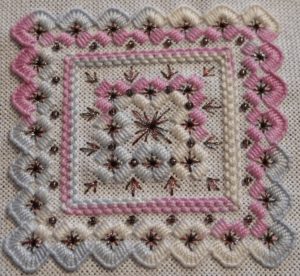
shafa.ua
Embroidery using the Hardanger technique is recognized as one of the most ancient techniques in the art of embroidery. According to some sources, the place of its origin is Ancient Egypt, but there is no reliable information about the appearance of the first works in this technique. As for the name Hardanger, this word has characteristic Scandinavian roots. Norway is famous for its bay of the same name, recognized as the longest on the planet. The origins of the Norwegian name go back to the seventeenth century. At this time, embroidery techniques began to actively develop. Women used it to decorate wedding dresses and national costumes.
Hardanger is an embroidery that has one bright distinctive element - a star with eight ends. A similar symbol is inherent in Indian knitted products. But despite this, this technique is considered Norwegian throughout the world.
The peak of popularity of technology occurred during the twentieth century. With its help, unique decorative fabrics and upholstery materials were created.Hardanger embroidery is ideal for decorating bed linen, curtains, and tablecloths.
What is Scandinavian embroidery used for?
The key to success in creating a masterpiece is the right foundation. In the Hardanger technique, pattern patterns indicate the need to use a warp with a uniform weave. This is explained by the need to cut out the main threads during embroidery. Standard canvas will not do the job. It is advisable to choose fabrics with a non-small count. The optimal canvas size is from 24 to 29. The process of embroidery on material with a smaller index is more labor-intensive. It will be difficult to trim the main thread.
The best option for work is a cotton base. The disadvantage of flax is the heterogeneity of its structure. Due to this, the elements of the drawing can be deformed, like the entire picture as a whole.
This technique belongs to the class of counted embroidery. The craftswoman needs to carefully calculate the cells of the base material. This is the only way to get an even pattern. To work with extremely thin canvas, you will need a magnifying glass. It will help you count the weaves of threads and carefully examine the cells of the fabric.
Hardanger - embroidery patterns, what you will need for work

shafa.ua
Another important step is the choice of material base. The quality of the thread largely depends on the result of the work. Experts recommend taking a closer look at the following options:
- Finka Perle.
- Lacemaker.
- Iris.
To work, you will need two types of such threads. Some should be slightly thicker than others. The base is embroidered with a thinner thread, and a thicker thread is used to create openwork decor. Modern needlewomen often use other types of yarn. Products made from multicolor and melange look original. For satin stitch details, familiar floss is suitable.The use of metallic threads is optimal for elegant embroidery.
If the design involves the use of beads for openwork cutting, it is best to give preference to the average size of beads, for example, number eleven or ten.
The technique uses embroidery needles. Scissors should have thin, sharp ends. Some craftswomen find it more convenient to work with a hoop. To fix the lining, an adhesive web is used.


 0
0





